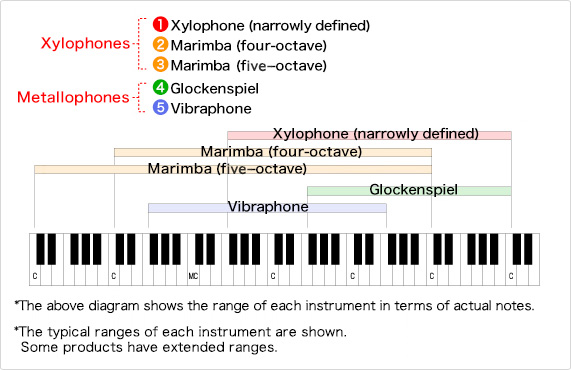The origins of the Marimba
Relatives of the marimba
The marimba is a relative of the xylophone
On a marimba, numerous wooden bars are lined up like piano keys; when these are struck, notes are produced. These bars are also called tone plates. An instrument that produces notes by striking bars can thus be called a tone-plate percussion instrument.
Among tone-plate percussion instruments, there are relatives of the xylophone, where the tone plates are made of wood, as well as the metallophone family, where the tone plates are made of metal. The marimba and the narrowly-defined xylophone are part of the xylophone family, while the glockenspiel, the vibraphone, and others are in the metallophone family.
The marimba has the widest range of any tone-plate percussion instrument.
Diagram of the ranges of the marimba and other tone-plate percussion instruments

Let's compare how the notes sound!
The xylophone looks something like a small marimba. Its register is higher than the marimba's, and the timbre of the notes is somewhat hard, standing out even among a crowd. In the metallophone family, the glockenspiel's tone plates are made of steel, while those of the vibraphone are made from an aluminum alloy. Both are made of metal, but the characters of their notes are very different. The glockenspiel produces gorgeous, showy notes, while the vibraphone plays notes that blend in with the instruments that it accompanies.
Try comparing how each instrument sounds.
Xylophone
Marimba
Glockenspiel
Vibraphone
Musical Instrument Guide : Marimba Contents
Origins
Structure
- What kind of instrument is the marimba?
- Inside and outside the resonator pipes
- There is craft to the design of the tone plates, too
- [Experiment1]Tone plate sanding depth and sound pitch experiment
- [Experiment2]Tone plate sanding location and sound pitch experiment
- [Experiment3]Try changing the material of the resonator pipes
